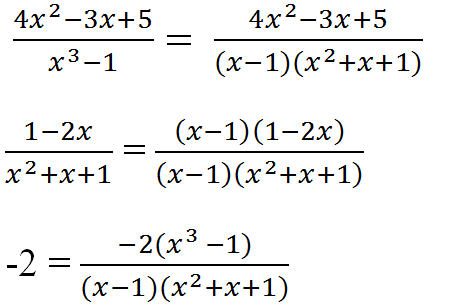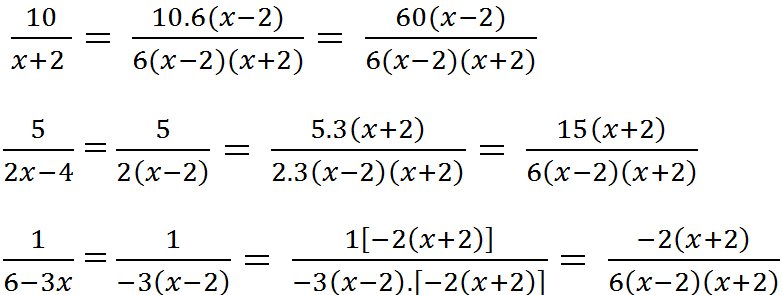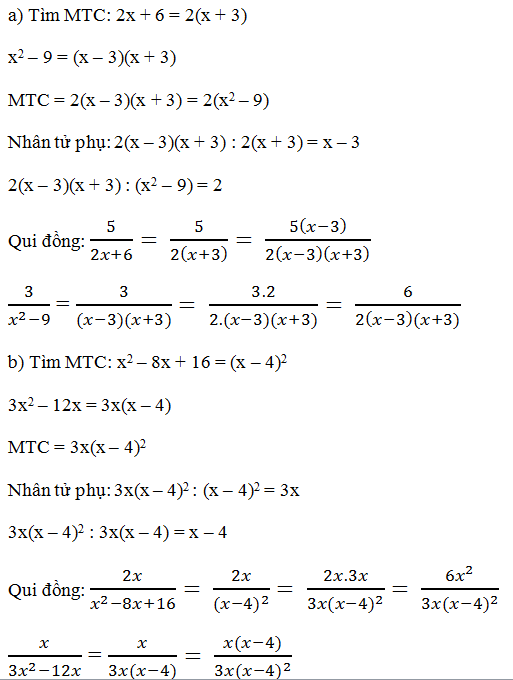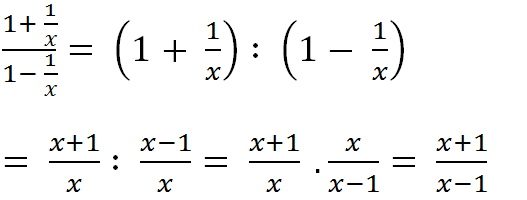Hãy nhập câu hỏi của bạn vào đây, nếu là tài khoản VIP, bạn sẽ được ưu tiên trả lời.

Bài 7:(Sbt/25) Dùng tính chất cơ bản của phân thức hoặc quy tắc đổi dấu để biến mỗi cặp phân thức sau thành một cặp phân thức bằng nó và có cùng mẫu thức :
a. \(\dfrac{3x}{x-5}\) và \(\dfrac{7x+2}{5-x}\)
Ta có:
\(\dfrac{3x}{x-5}=\dfrac{-\left(3x\right)}{-\left(x-5\right)}=\dfrac{-3x}{5-x}\)
\(\dfrac{7x+2}{5-x}\)
Vậy .....
b.\(\dfrac{4x}{x+1}\) và \(\dfrac{3x}{x-1}\)
Ta có:
\(\dfrac{4x}{x+1}=\dfrac{4x\left(x-1\right)}{\left(x+1\right)\left(x-1\right)}=\dfrac{4x^2-4x}{x^2-1}\)
\(\dfrac{3x}{x-1}=\dfrac{3x\left(x+1\right)}{\left(x-1\right)\left(x+1\right)}=\dfrac{3x^2+3x}{x^2-1}\)
Vậy ..........
c. \(\dfrac{2}{x^2+8x+16}\) và \(\dfrac{x-4}{2x+8}\)
Ta có:
\(\dfrac{2}{x^2+8x+16}=\dfrac{4}{2\left(x+4\right)^2}\)
\(\dfrac{x-4}{2x+8}=\dfrac{\left(x-4\right)\left(x+4\right)}{2\left(x+4\right)\left(x+4\right)}=\dfrac{x^2-16}{2\left(x+4\right)^2}\)
Vậy .........
d. \(\dfrac{2x}{\left(x+1\right)\left(x-3\right)}\) và \(\dfrac{x+3}{\left(x+1\right)\left(x-2\right)}\)
Ta có:
\(\dfrac{2x}{\left(x+1\right)\left(x-3\right)}=\dfrac{2x\left(x-2\right)}{\left(x+1\right)\left(x-3\right)\left(x-2\right)}=\dfrac{2x^2-4x}{\left(x+1\right)\left(x-2\right)\left(x-3\right)}\)
\(\dfrac{x+3}{\left(x+1\right)\left(x-2\right)}=\dfrac{\left(x+3\right)\left(x-3\right)}{\left(x+1\right)\left(x-2\right)\left(x-3\right)}=\dfrac{x^2-9}{\left(x+1\right)\left(x-2\right)\left(x-3\right)}\)
Vậy .........

Bài 6:(Sbt/25) Dùng tính chất cơ bản của phân thức để biến đổi mỗi cặp phân thức sau thành một cặp phân thức bằng nó và có cùng tử thức :
a) \(\dfrac{3}{x+2}\)và\(\dfrac{x-1}{5x}\)
Ta có:
\(\dfrac{3}{x+2}\) = \(\dfrac{3.\left(x-1\right)}{\left(x+2\right)\left(x-1\right)}\) = \(\dfrac{3x-3}{x^2+x-2}\)
\(\dfrac{x-1}{5x}\) = \(\dfrac{\left(x-1\right).3}{5x.3}\) =\(\dfrac{3x-3}{15x}\)
Vậy .....
b. \(\dfrac{x+5}{4x}\) và \(\dfrac{x^2-25}{2x+3}\)
Ta có:
\(\dfrac{x+5}{4x}\) = \(\dfrac{\left(x+5\right)\left(x-5\right)}{4x.\left(x-5\right)}\) = \(\dfrac{x^2-25}{4x^2-20x}\)
\(\dfrac{x^2-25}{2x+3}\)
Vậy .....

a) Tìm MTC: x3 – 1 = (x – 1)(x2 + x + 1)
Nên MTC = (x – 1)(x2 + x + 1)
Nhân tử phụ:
(x3 – 1) : (x3 – 1) = 1
(x – 1)(x2 + x + 1) : (x2 + x + 1) = x – 1
(x – 1)(x2+ x + 1) : 1 = (x – 1)(x2 + x + 1)
Qui đồng:
b) Tìm MTC: x + 2
2x – 4 = 2(x – 2)
6 – 3x = 3(2 – x)
MTC = 6(x – 2)(x + 2)
Nhân tử phụ:
6(x – 2)(x + 2) : (x + 2) = 6(x – 2)
6(x – 2)(x + 2) : 2(x – 2) = 3(x + 2)
6(x – 2)(x + 2) : -3(x – 2) = -2(x + 2)
Qui đồng:

a) Tìm MTC:
2x + 6 = 2(x + 3)
x2 – 9 = (x – 3)(x + 3)
MTC = 2(x – 3)(x + 3) = 2(x2 – 9)
Nhân tử phụ:
2(x – 3)(x + 3) : 2(x + 3) = x – 3
2(x – 3)(x + 3) : (x2 – 9) = 2
Qui đồng:
b) Tìm MTC:
x2 – 8x + 16 = (x – 4)2
3x2 – 12x = 3x(x – 4)
MTC = 3x(x – 4)2
Nhân tử phụ:
3x(x – 4)2 : (x – 4)2 = 3x
3x(x – 4)2 : 3x(x – 4) = x – 4
Qui đồng:

\(\frac{4}{x^2-9}=\frac{4}{\left(x-3\right)\left(x+3\right)}=\frac{4x}{x\left(x-3\right)\left(x+3\right)}\)
\(\frac{1-x}{3x-x^2}=\frac{x-1}{x^2-3x}=\frac{\left(x-1\right)\left(x+3\right)}{x\left(x-3\right)\left(x+3\right)}\)

\(A=\dfrac{\dfrac{x}{x-1}-\dfrac{x+1}{x}}{\dfrac{x}{x+1}-\dfrac{x-1}{x}}=\dfrac{\dfrac{x^2-\left(x^2-1\right)}{x\left(x-1\right)}}{\dfrac{x^2-\left(x^2-1\right)}{x\left(x+1\right)}}=\dfrac{\dfrac{1}{x\left(x-1\right)}}{\dfrac{1}{x\left(x+1\right)}}\)
\(\Leftrightarrow\left\{{}\begin{matrix}x\ne\left\{0;\pm1\right\}\\A=\dfrac{x+1}{x-1}\end{matrix}\right.\)







\(\dfrac{3x}{x+3}=\dfrac{3x\left(x-3\right)}{\left(x+3\right)\left(x-3\right)}=\dfrac{3x^2-9x}{x^2-9}\)
\(\dfrac{x-1}{x-3}=\dfrac{\left(x-1\right)\left(x+3\right)}{\left(x-3\right)\left(x+3\right)}=\dfrac{x^2+2x-3}{x^2-9}\)
\(x^2+9=\dfrac{\left(x^2+9\right)\left(x^2-9\right)}{x^2-9}=\dfrac{x^4-81}{x^2-9}\)